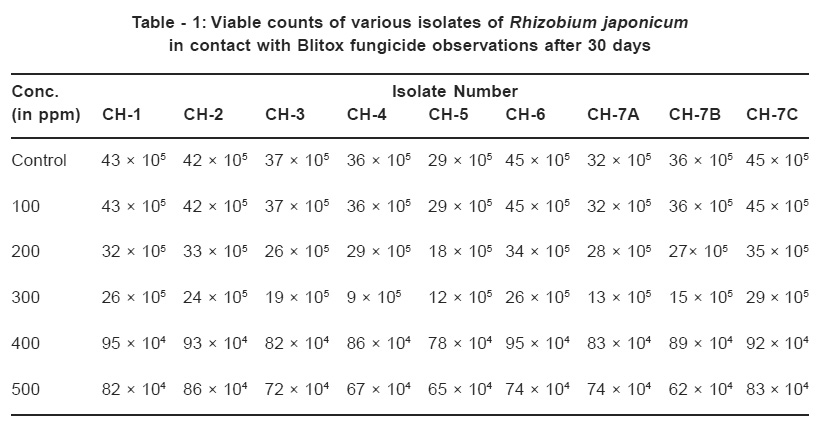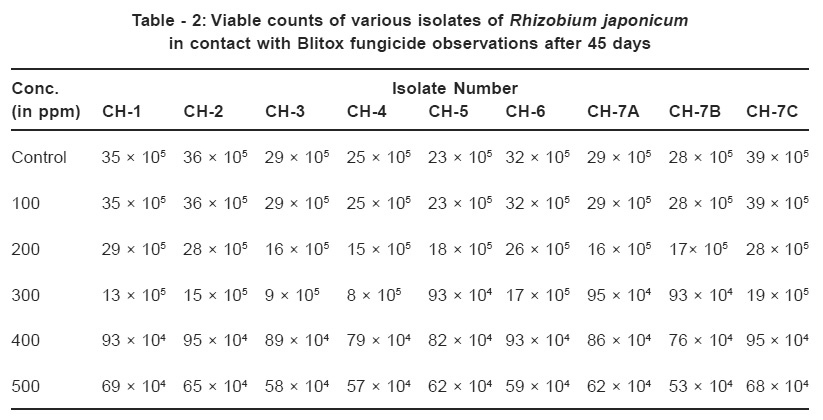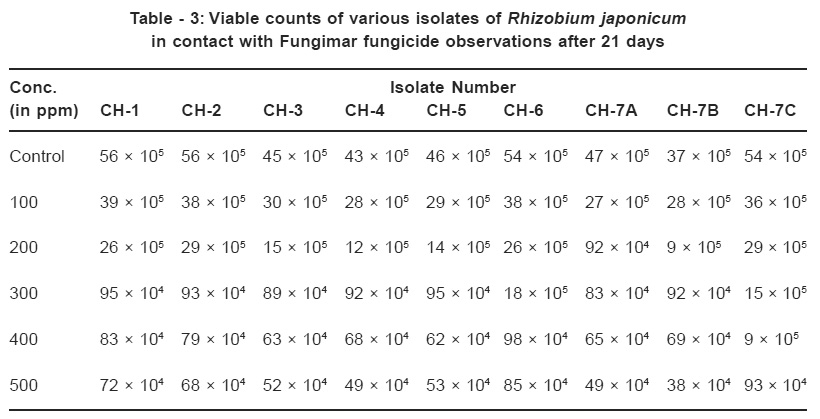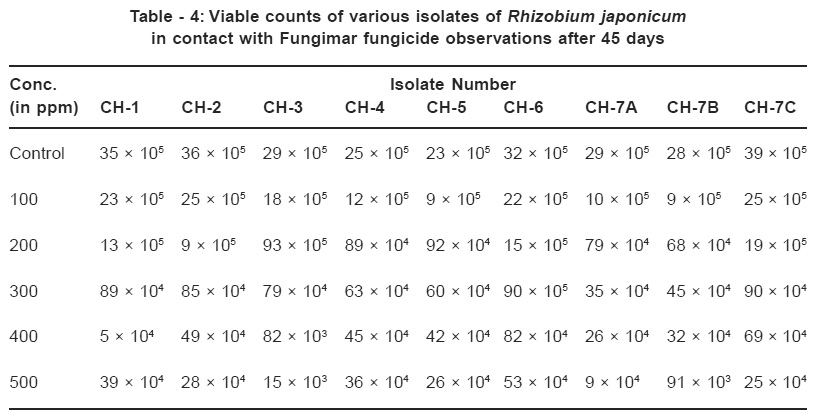Interaction studies of copper fungicides with biological environment of soil
Charanjit Kaur1 * , P. Maini2 and N.P. Shukla3
1
Department of Chemistry,
Sri Satya Sai College for Women,
Bhopal P.O Habibganj, BHEL,
Bhopal,
India
2
Institute of Excellence in Higher Education,
Kolar Road,
Bhopal,
India
3
MPCST, Vigyan Bhawan,
Bhopal,
462 023
India
DOI: http://dx.doi.org/10.12944/CWE.2.1.19
Fungicides are one of the essential inputs in the improved technology for increasing crop production through crop protection. Copper fungicides Blitox and Fungimar are used widely as foliar sprays for control of many plant diseases. As major portion of fungicides applied to economically important crops eventually finds its way to soil, may disrupt the activities of microorganisms in the soil and thereby altering the biological equilibrium of soil. It is therefore planned to study the biological health of the soil with the help of viable counts of nine strains of Rhizobium japonicum after 21, 30 and 45 days intervals at 100 to 500 ppm concentrations of the two copper Fungicides. Results reveal that Blitox is more compatible than Fungimar to R. japonicum.
Copy the following to cite this article:
Kaur C, Maini P, Shukla N.P. Interaction studies of copper fungicides with biological environment of soil. Curr World Environ 2007;2(1):89-92 DOI:http://dx.doi.org/10.12944/CWE.2.1.19
Copy the following to cite this URL:
Kaur C, Maini P, Shukla N.P. Interaction studies of copper fungicides with biological environment of soil. Curr World Environ 2007;2(1):89-92. Available from: http://www.cwejournal.org/?p=647
Download article (pdf) Citation Manager Publish History
Select type of program for download
| Endnote EndNote format (Mac & Win) | |
| Reference Manager Ris format (Win only) | |
| Procite Ris format (Win only) | |
| Medlars Format | |
| RefWorks Format RefWorks format (Mac & Win) | |
| BibTex Format BibTex format (Mac & Win) |
Article Publishing History
| Received: | 2007-03-20 |
|---|---|
| Accepted: | 2007-05-10 |
Introduction
With the advent of high yielding crop varieties, the pest problems have become more acute, adversely affecting the crop yields. Fungicides are therefore, one of the major inputs in the improved technology for increasing crop production through crop protection, (Dharival and Singh 1993). A major portion of fungicides applied to economically important crops eventually finds its way to soil or aquatic system. On reaching the soil, the fungicides and /or their degradation products may disrupt the activities of the microorganisms in the soil and thereby alter its biological equilibrium with eventual repercussions in soil health, leading to agro ecological problems of great concern.
As copper fungicides are widely used for the control of many vegetables, fruits and flowering plant diseases, therefore the present study was planned.
Material and Methods
Black cotton soil samples were collected and sterilized in an autoclave for three consecutive days at 121°C for two hours per day, (Agarwal et al., 1986). Five days old cultures of Bradyrhizobium japonicum having 10 8 cells/ml were added to soil in the ratio of 10 ml of both culture in 100 gms of soil, (Neena, 1992). Calculated quantities of fungicide solution were added to maintain the concentration of 100, 200, 300, 400, and 500 ppm. The contents were mixed thoroughly and packed in low density polythene bags of 200 gauge sealed by electric sealer and kept for 21, 30, and 45 days at 28 + 2°C. After completion of desired incubation period soil samples were withdrawn and used for colony counting with the help of colony counter, (Horshall 1956).
 |
Table - 1: Viable counts of various isolates of Rhizobium japonicum in contact with Blitox fungicide observations after 30 days Click here to view table |
 |
Table - 2: Viable counts of various isolates of Rhizobium japonicum in contact with Blitox fungicide observations after 45 days Click here to view table |
 |
Table - 3: Viable counts of various isolates of Rhizobium japonicum in contact with Fungimar fungicide observations after 21 days Click here to view table |
 |
Table - 4: Viable counts of various isolates of Rhizobium japonicum in contact with Fungimar fungicide observations after 45 days Click here to view table |
Results and Discussion
The survival studies of isolates of R.japonicum in contact with Fungicides (Blitox and Fungimar) reveal a decrease with respect to increasing the concentration of fungicides from 100 to 500 ppm and also on increasing the time of contact.
At 100 ppm concentration of Blitox fungicides viable counts decrease from 56 x 105 to 23 x 105, at 200 ppm concentration 56 x 105 to 15 x 104, at 300 ppm concentration 46 x 105 to 93 x 104, at 400 ppm concentration from 35x105 to 76 x 104 and at 500 ppm concentration 26 x 105 to 53 x104.
Observations with Fungimar Fungicide viable counts decrease from 39 x 105 to 9 x 105 at 100 ppm, from 29 x 105 to 68 x 104 at 200 ppm, from 15 x 10 5 to 35 x 10 4 at 300 ppm, from 9 x 10 5 to 26 x 10 4 at 400 ppm, from 93 x 10 4 to 15 x 10 3 at 500 ppm concentration. Observations suggest that Blitox is more compatible than Fungimar to R. Japonicum. Fungitoxic component of Copper Fungicides is the cupric ion for which little biochemical specificity exists, (Somers E 1961) the strong inhibitory action of Fungimar in comparison to Blitox is attributed to its strong bonding affinity to amino & carboxylic groups .It reacts with protein and acts as an enzyme inhibitor (The agrochemical hand book 1987). Among the strains CH-1, CH-2, CH-6 and CH-7C were observed to give higher counts suggesting better quality strains than others. There is not much difference in the viable counts of organism in the fungicide treated soils and untreated control therefore fungicide treatment can safely be used as a routine.
References
- Dhariwal, G.S and Balvinder Singh., Pestic. their ecological impact in developing countries. Commonwealth Publ., India (1993).
- Agrawal , T C Neeru Narula and Gupta K G., Effect of Carbamate Pesticides on Nodulation, plant yield and nitrogen fixation by Pisum sativum and Vigna in presence of their respective Rhizobia. Plant & Soil, 94: (1986) 125-132.
- Neena Jhanda., Studies of interaction of chemical environment of soil with nitrogen fixing bacteria in particular to Rhizobium species. Ph.D. Thesis {Chemistry}, Barkatullah University (1992).
- Horshall, J.G., Principles of fungicidal action. Cronica Botanica Co. Waltham Mass (1956).
- Somers, E ., The Fungitoxicity of metal ions. Appl. Biol. (1961) 49, 246.
- The agrochemical Handbook, Second Ed. Royal Society of Chemistry. The University of Nottingham, NG 7, 2RD England (1987).







